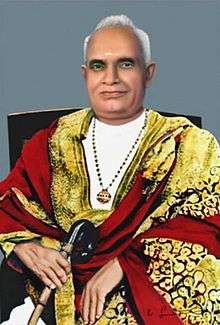Mannathu Padmanabha Pillai
| Bharata Kesari Mannathu Padmanabha Pillai PB | |
|---|---|
 Mannathu Padmanabhan | |
| Born |
2 January 1878 Travancore, British India |
| Died | 25 February 1970 (aged 93) Perunna, Changanassery |
| Monuments | Mannam Memorial, Changanassery |
| Nationality | Indian |
| Occupation | Social reformer, teacher, lawyer, politician |
| Era | Reformation in Kerala |
| Known for | Founder of Nair Service Society |
| Home town | Perunna |
| Movement |
Savarna Jadha Vaikom Satyagraha Vimochana Samaram |
| Board member of | Travancore Devaswom Board |
| Religion | Hinduism |
| Spouse(s) | Thottakkattu Madhavi Amma |
| Parent(s) |
Nilavana Illam Eswaran Namboothiri (father) Mannathu Parvathy Amma (mother) |
| Honours | Padma Bhushan |
Mannathu Padmanabhan (2 January 1878 – 25 February 1970) was a social reformer and a freedom fighter from the State of Kerala, India. He is recognised as the founder of the Nair Service Society, which claims to represent the Nair community that constitutes almost 14.5% of the population of the state.[1] Padmanabhan is considered as a visionary reformer who organised the Nair community under the NSS.[2]
Early life
Mannathu Padmanathan was born in Perunna village in Changanacherry, Travancore, British India on 2 January 1878 to Eswaran Namboothiri of Nilavana Illam and Mannathu Parvathy Amma. He began his career as a teacher in 1893 in a Government primary school. After a few years, from 1905 he changed his profession and started practising law, in the Magistrates Courts.[2][3]
Nair Service Society
On 31 October 1914 with the help of a few others, he established the Nair Service Society. His main ambition was to uplift the status of the Nair community. From 1915 onwards, he gave up law practice and became full-time secretary of the Nair Service Society.[3] Mannam revived and reshaped the old concept of village societies, the Karayogams, which practically set the tenor of family and village life. In 1924-25 the NSS persuaded the Travancore Government to enact the Nair Regulation which broke up the materiarchal joint family providing for paternal and maternal property to divided among all the children.[2]
He fought for social equality, the first phase of being the Vaikom Satyagraha, demanding the public roads near the temple at Vaikom be opened to low caste Hindus. In 1924 he took part in the Vaikom and Guruvayoor temple-entry and anti-untouchability agitation. He opened his family temple for everyone, irrespective of caste distinction[4] He became a member of the Indian National Congress in 1947 and took part in the agitation against Sir C. P. Ramaswamy Iyer’s administration in Travancore.[3] As the first president of Travancore Devaswom Board he revitalised many temples which had almost ceased to function.[2]
In 1949 Padmanabhan became a member of the Travancore Legislative Assembly. In 1959 he along with Christian Churches led a united opposition against the State Communist Ministry, which became known as the Vimochana Samaram (liberation struggle). The cause of the Vimochana Samaram was the introduction of an Education Bill by the Minister of Education, Joseph Mundassery, and the movement caused the dismissal of the Communist government under E. M. S. Namboodiripad on 31 July 1959.[2] The consequence of this was the beginning of President’s rule in the state under Article 356 of the Indian Constitution.[3][5] In 1964 he was instrumental in the formation of Kerala Congress, the first regional party in India
Padmanabhan was involved with the Nair Service Society as its Secretary for 31 years and as its President for three years. He was honoured with the title Bharata Kesari by the President of India.[3] He also received Padma Bhushan in 1966.[2][6]
Death
He died on 25 February 1970[3] at the age of 93. Mannam memorial (or Samādhi) is located at NSS Headquarters Changanacherry. He is regarded as the reformer and moral guide of Nairs.
See also
Notes
- ↑ Socio Economic Survey by GOvt. of Kerala, 1968
- 1 2 3 4 5 6 "M. Padmanabhan". IndianPost, Govt of India. Retrieved 2012-04-25.
- 1 2 3 4 5 6 Mannathu Padmanabhan (1878-1970) - MINISTRY OF INFORMATION AND BROADCASTING, Govt of India
- ↑ Mannam-The Hindu
- ↑ ‘Liberation’ struggle - Kerala's First Government
- ↑ KERALA - THE GOD'S OWN COUNTRY THROUGH INDIAN STAMPS
References
- V. Balakrishnan & R. Leela Devi, 1982, Mannathu Padmanabhan and the revival of Nairs in Kerala, Vikas Publishing House, New Delhi.
| Wikimedia Commons has media related to Mannathu Padmanabha Pillai. |
- Brief Biography by Ministry of Information and Broadcasting, Government of INDIA
- Mannathu Padmanabhan-Indian Post